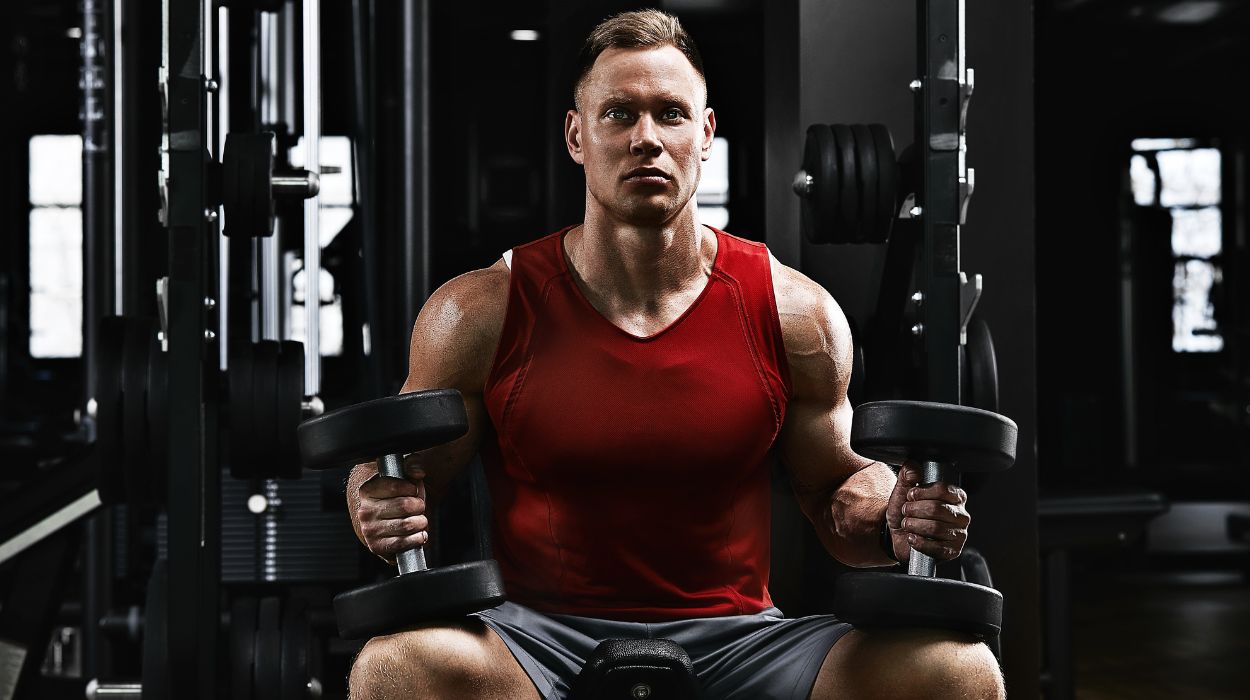
Finding a complete back and shoulder workout with dumbbells can be a challenging task. When trying to sculpt the perfect back, we usually think of lat pulldowns and row machines as the primary pieces of equipment. However, we tend to overlook the classical dumbbells, which are a convenient and easily accessible set of equipment.
There are numerous ways to improve your upper body strength while growing your shoulder muscles and back using dumbbells.
Best Shoulder And Back Workout With Dumbbells
These exercises help build muscle symmetry, improve posture, and aid in pain and stress management. They help create a resilient upper body and improve functional strength for everyday activities that involve pushing, pulling, or carrying.
Back And Shoulder Workout With Dumbbells In 2024
Discover the secret potential of your shoulders and shape your back with these seven dumbbell exercises. These exercises target each muscle group to give you the toned arms and back you desire. With minimal equipment needed, you can try these workouts at home or at your favorite gym.
Seated Dumbbell Shoulder Press
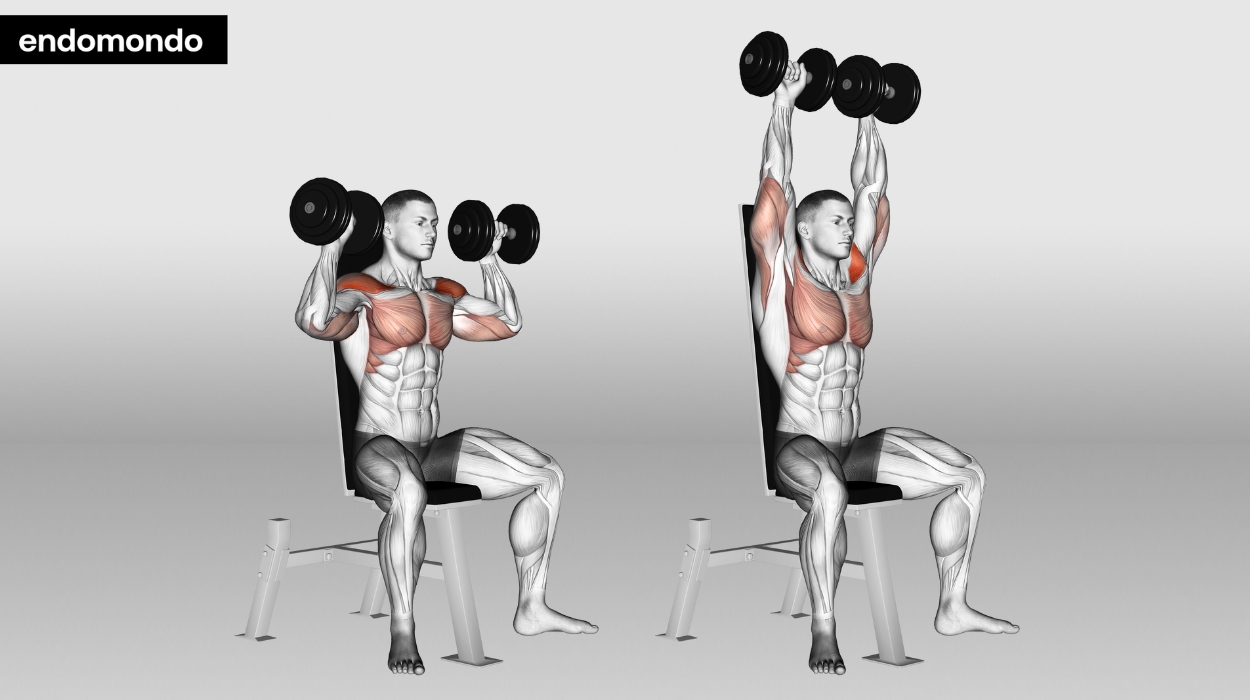
Seated dumbbell presses are a variation of the standard military press that emphasizes the anterior deltoid.[1] It’s a great compound movement that simulates pushing and lifting objects overhead and can be a great addition to building strength in your upper arms.
How to do:
- Start in a seated position holding a dumbbell in each hand with your palms facing forward and your hands at shoulder height.
- Breathe out slowly, extend your arms, and raise the dumbbells up until your elbows are nearly straight but not locked and the dumbbells are above your head.
- Hold at the top position, and you should feel a squeeze in the front part of your shoulder.
- Lower the weights slowly to the starting position and repeat the movement.
Tips:
- Do not lock your elbows in the top part of the movement.
- By locking your elbows, you could be at risk of a hyperextension injury.
- You can also perform this activity while sitting on a medicine ball for an extra challenge to your core.
Optimal Sets and Reps: Repeat 10-15 reps per set for 2-3 sets. For a more advanced variation, you could perform a standing dumbbell squat and transition into an overhead press to add a total body component to your exercise.
Standing Dumbbell Lateral Shoulder Raises
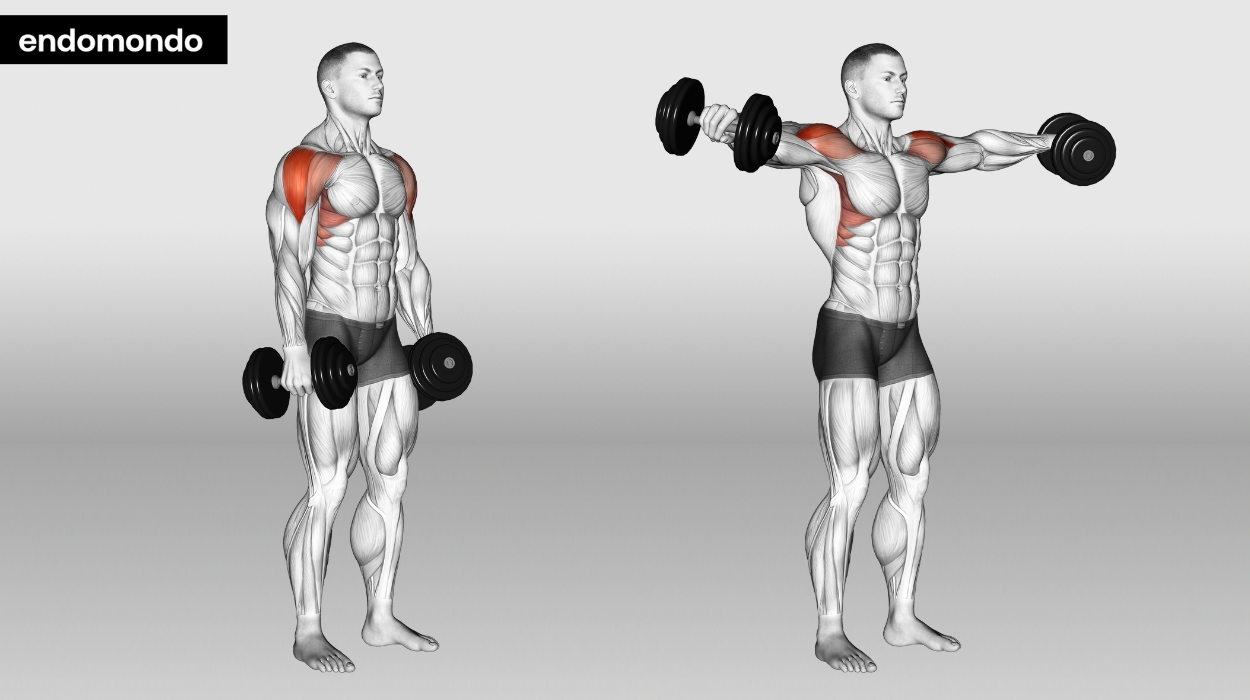
Whereas front shoulder raises and shoulder presses primarily target the anterior deltoid, a dumbbell lateral raise is a great way to strengthen the middle deltoids and build strong, balanced shoulders.
How to do:
- Start in a standing position with your feet shoulder-width apart.
- Keep your core tight and hold a dumbbell in each hand with your palms facing towards your body.
- With your knees slightly bent, slowly raise your arms at your sides until your palms face the floor.
- Once you reach the top position, hold for 1-2 seconds and slowly lower the weights to the starting position.
Tips:
- Some people tend to swing their bodies when performing lateral raises; try to isolate the movement strictly to your shoulders.
- Keep your elbows slightly bent to help reduce stress on the shoulder joint.
- Make sure to avoid pointing your thumb downwards.
Optimal Sets and Reps: Start with 10-15 reps for 2-3 sets with light weights. Then progress to 6-10 reps as you continue to build strength and use heavier weights.
Standing Dumbbell Front Shoulder Raises
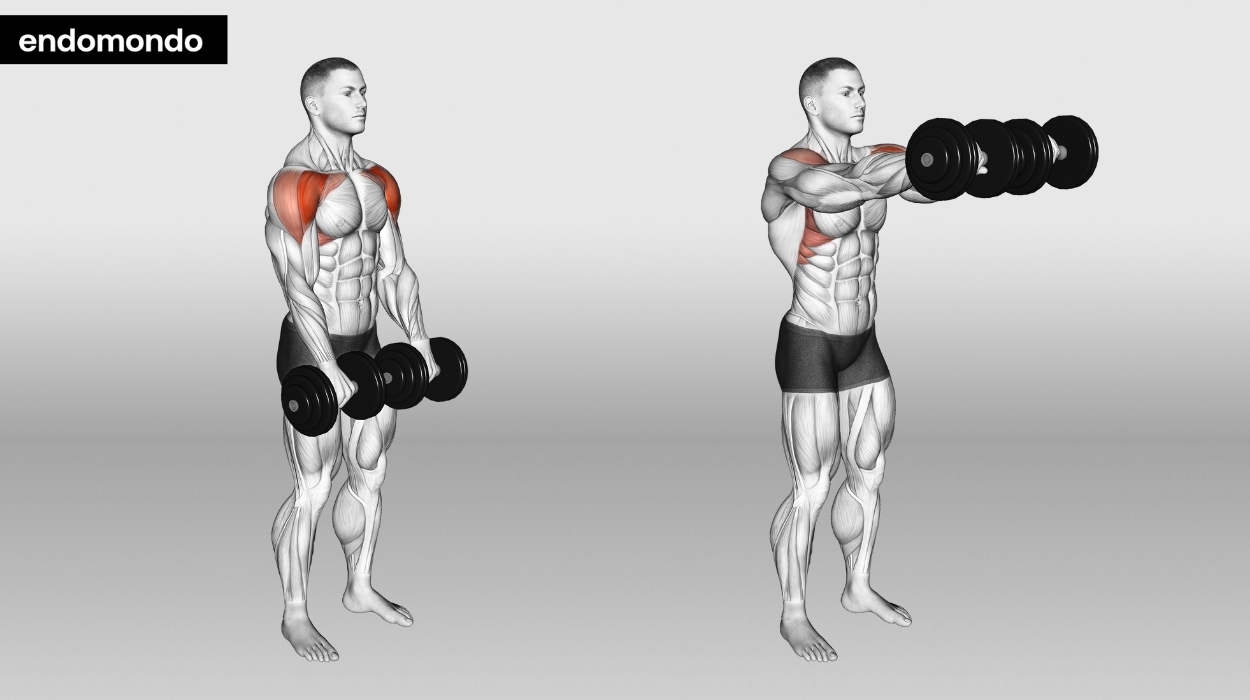
For a great front delt workout, front shoulder raises are an effective exercise to target the anterior deltoid. The front delts are important when it comes to motions that involve pushing or pressing and can lead to the appearance of a balanced frame.
How to do:
- To begin this exercise, stand with your feet shoulder-width apart, holding a dumbbell in each hand.
- With your palms facing you, lift the dumbbells up and out until shoulder height so they are directly in front of you.
- Hold this position for a few seconds and return back to the starting position.
- Repeat for as many repetitions as needed.
Tips:
- Front raises require stability and core control for proper form. Try to limit forward momentum.
- Start with lighter weights to get familiar with the movement pattern.
Optimal Sets and Reps:
When choosing a set and rep range for your workouts, it’s important to select something that you’re most comfortable with. Studies[2] have shown a broad range of reps and sets that can lead to muscle growth or hypertrophy.
Instead of worrying about an optimal rep range, focus on challenging yourself and selecting a resistance that brings you close to failure, with about three to four repetitions left in reserve.
Kneeling Dumbbell One-Arm Row
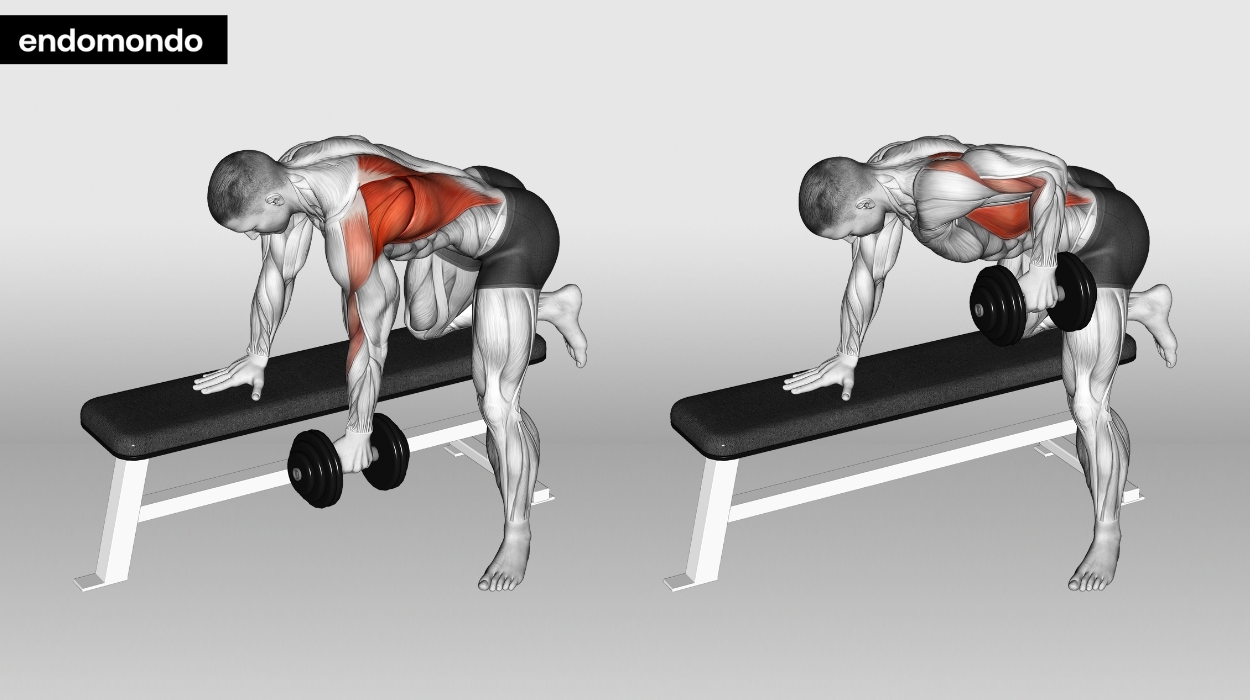
Looking for new ways to incorporate back exercises into your routine?
Consider adding a one-arm row. This exercise is highly functional, as it imitates everyday movements like lifting heavy objects or pulling things. Additionally, it targets the rear delts, middle traps, and rhomboids, making it an excellent strengthening exercise.
How to do:
- Start by placing one knee and outstretched arm on the bench and then position the opposite foot on the floor.
- Let a dumbbell hang by your opposite side. Pull the dumbbell up to your chest slowly until your elbow is bent and the weight almost makes contact with your chest.
- Hold this position for a few seconds, then bring the dumbbell back to the starting position.
- Repeat for the desired number of reps and sets, then switch with the opposite arm.
Tips:
- Keep your head and neck in a neutral position by looking down throughout the exercise.
- Try to maintain a tight torso in order to limit trunk rotation.
- Focus on breathing out as you pull the weight up towards your chest.
Optimal Sets and Reps:
Find a comfortable range for you. Beginners might find that three sets of 10-15 repetitions are a good starting point. A rep range of 6-8 could be more suitable for intermediate to advanced lifters.
Standing Dumbbell Shoulder Shrug
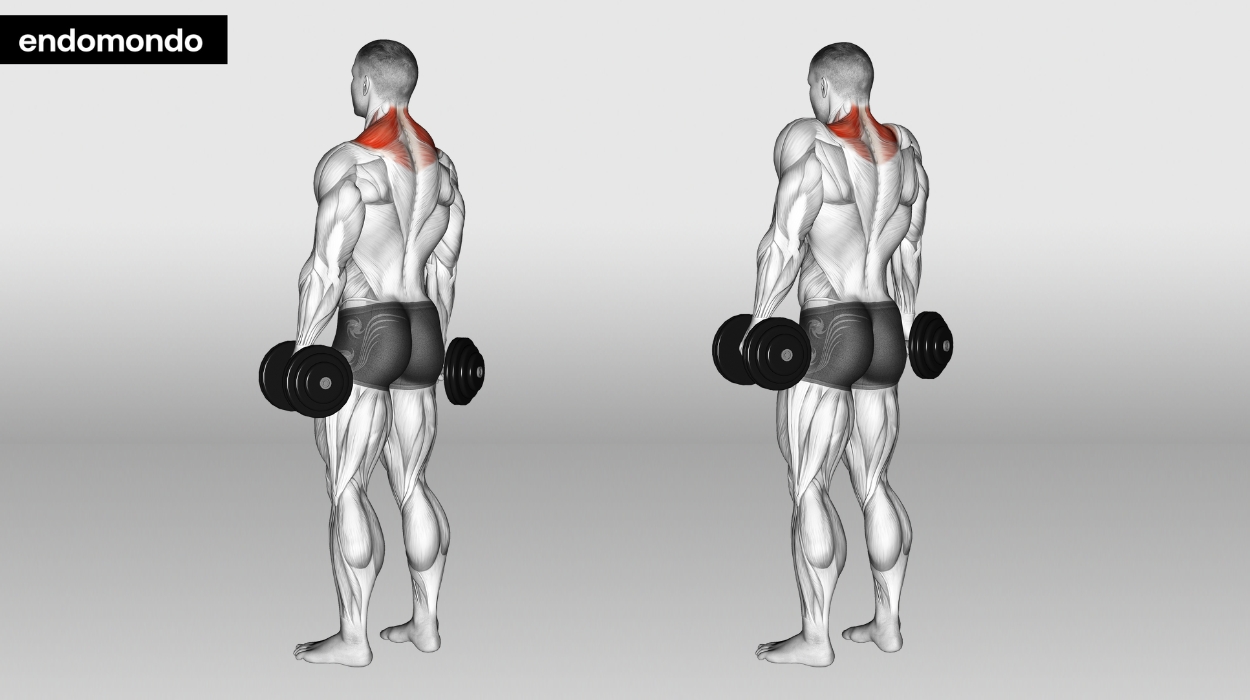
The function of the upper traps is to elevate your shoulder blades, and the dumbbell shoulder shrug does exactly that. This exercise is a must-have for any upper back routine. It’s also a great way to improve your grip strength and replicate carrying heavy grocery bags.
How to do:
- Stand with your feet shoulder-width apart with a dumbbell in each hand and arms by your side.
- Slowly tuck your shoulders back and lift the weights up as if you’re bringing your shoulders up to your ears.
- Keep your elbows bent and hold for a few seconds, then return to the resting position.
Tips:
- Keep your cervical spine and neck neutral by looking straight ahead during the exercise.
- Avoid excessively rolling your shoulders. Rather, imagine you are gently squeezing your shoulder blades together and lifting straight up.
Optimal Sets and Reps:
A good starting point for beginners is three sets of 10-15 reps. Intermediate to advanced lifters may opt for a rep range of 6-8 reps.
Standing Dumbbell Upright Row
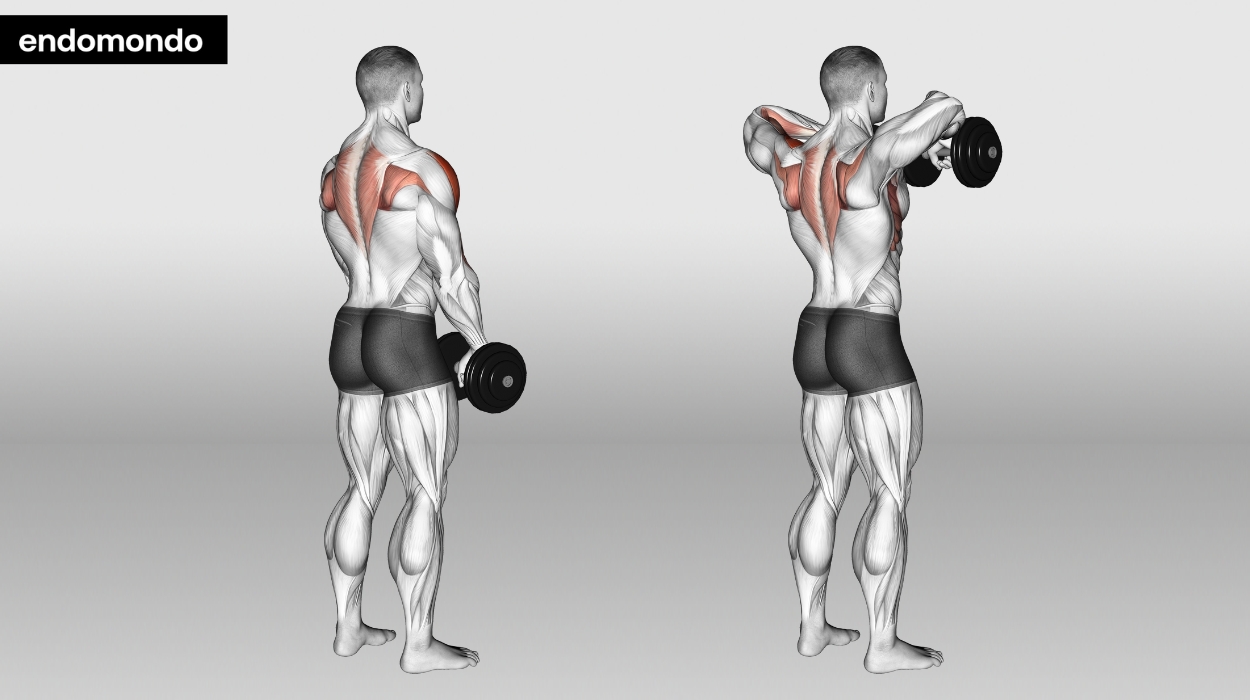
If you’re looking to add variety to your shoulder and back workout with dumbbells, give upright rows a try. This exercise helps target your upper back, deltoids, traps, and even your biceps.
How to do:
- Stand with your feet hip-width apart.
- Hold a dumbbell in each hand, with your palms pointed towards you.
- Start raising the dumbbell to chin level as you bend your elbows.
- Hold for a second at the top of the position, then return back to the starting position.
Tips:
- Use a wider grip of a couple of inches past shoulder width to maximize deltoid and upper trapezius involvement.
- Keep your trunk stationary and brace your core throughout the movement to limit twisting, turning, arching, or other compensation patterns.
- For an additional challenge, you can transition into a plank position at the end of the movement.
Optimal Sets and Reps:
A good starting point for beginners is three sets of 10-15 reps. Intermediate to advanced lifters may opt for a rep range of 6-8 reps.
Bent-Over Dumbbell Reverse Fly

The bent-over reverse fly is a fantastic exercise that targets the rear deltoid muscles. Often, the anterior deltoid muscles get more attention than the rear delts, and this exercise helps to balance this out.
The bent-over reverse fly is an effective way to engage your posterior deltoid, rhomboid, and middle trapezius muscles, which can help give your shoulders a more defined and sculpted look.
How to do:
- Start by standing with your feet shoulder-width apart and holding a dumbbell in each hand.
- Bend down so that your chest is parallel to the floor.
- Slowly move your arms up and out until you raise the weights to head level.
- Hold for a count and return back to the starting position.
Tips:
- Squeeze your shoulder blades together during the lift.
- Keep your head and neck in a neutral position while looking down at the floor.
Optimal Sets and Reps:
A good starting point for beginners is three sets of 10-15 reps. Intermediate to advanced lifters may opt for a rep range of 6-8 reps.
Benefits Of Back And Shoulder Exercises
Muscle Symmetry
Focusing on strengthening the muscles of your shoulders and back can help prevent muscle imbalances. It can sometimes be challenging to come up with mid-back exercises, so having a well-rounded routine is crucial. A stronger back and pair of shoulders can also help improve the daily functionality of activities like lifting overhead, carrying items, and reaching for objects more easily.
Improved Posture
Your posture can greatly benefit from strengthening your back and shoulder muscles. By adding shoulder workouts to your exercise routine, you can improve your posture,[3] reduce pain, and increase your ability to maintain different neck positions for longer periods of time.
Pain And Stress Management
Adding these dumbbell exercises can also be highly beneficial for pain management. For example, recent studies have shown that shoulder shrugs, lateral raises and upright rows can help people suffering from chronic neck pain.[4]
Additionally, it’s no secret[5] that being physically active and exercising can have a positive overall effect on mental well-being. It can even lead to less anxiety or depressive symptoms.
Conclusion
Do you want to build muscle or add more variety to your shoulder and back workouts with dumbbells?
These dumbbell exercises can improve your posture, reduce pain, and enhance your overall well-being.
Remember that safety is always a priority. Choose a weight that feels comfortable to you before you start increasing the intensity.
Frequently Asked Questions
Training the two muscle groups in one session can optimize your workout time, improve muscle development, and promote a balanced physique.
Yes, combining exercises for a back and shoulder dumbbell workout is an efficient way to build strength, allowing for strategic rest and recovery periods to meet your fitness goals.
Yes, dumbbell shrugs are a safe and effective exercise to target your upper traps and deltoids. Additionally, you can superset the exercise with upright rows to maximize muscle activation of the trapezius and deltoid muscle groups.
Resources
- Yuri, Vianna, J.M., Guimarães, M.P., Jorge, Hernández-Mosqueira, C., Silva and Marchetti, P.H. (2020). Different Shoulder Exercises Affect the Activation of Deltoid Portions in Resistance-Trained Individuals. Journal of Human Kinetics, [online] 75(1), pp.5–14. doi:https://doi.org/10.2478/hukin-2020-0033.
- Krzysztofik, M., Wilk, M., Grzegorz Wojdała and Artur Gołaś (2019). Maximizing Muscle Hypertrophy: A Systematic Review of Advanced Resistance Training Techniques and Methods. International Journal of Environmental Research and Public Health, [online] 16(24), pp.4897–4897. doi:https://doi.org/10.3390/ijerph16244897.
- Kim, D., Cho, M., Park, Y. and Yang, Y. (2015). Effect of an exercise program for posture correction on musculoskeletal pain. Journal of Physical Therapy Science, [online] 27(6), pp.1791–1794. doi:https://doi.org/10.1589/jpts.27.1791.
- Li, X., Lin, C., Liu, C., Ke, S., Wan, Q., Luo, H., Huang, Z., Xin, W., Ma, C. and Wu, S. (2017). Comparison of the effectiveness of resistance training in women with chronic computer-related neck pain: a randomized controlled study. International Archives of Occupational and Environmental Health, [online] 90(7), pp.673–683. doi:https://doi.org/10.1007/s00420-017-1230-2.
- Aditya Mahindru, Patil, P. and Agrawal, V. (2023). Role of Physical Activity on Mental Health and Well-Being: A Review. Cureus. [online] doi:https://doi.org/10.7759/cureus.33475.




